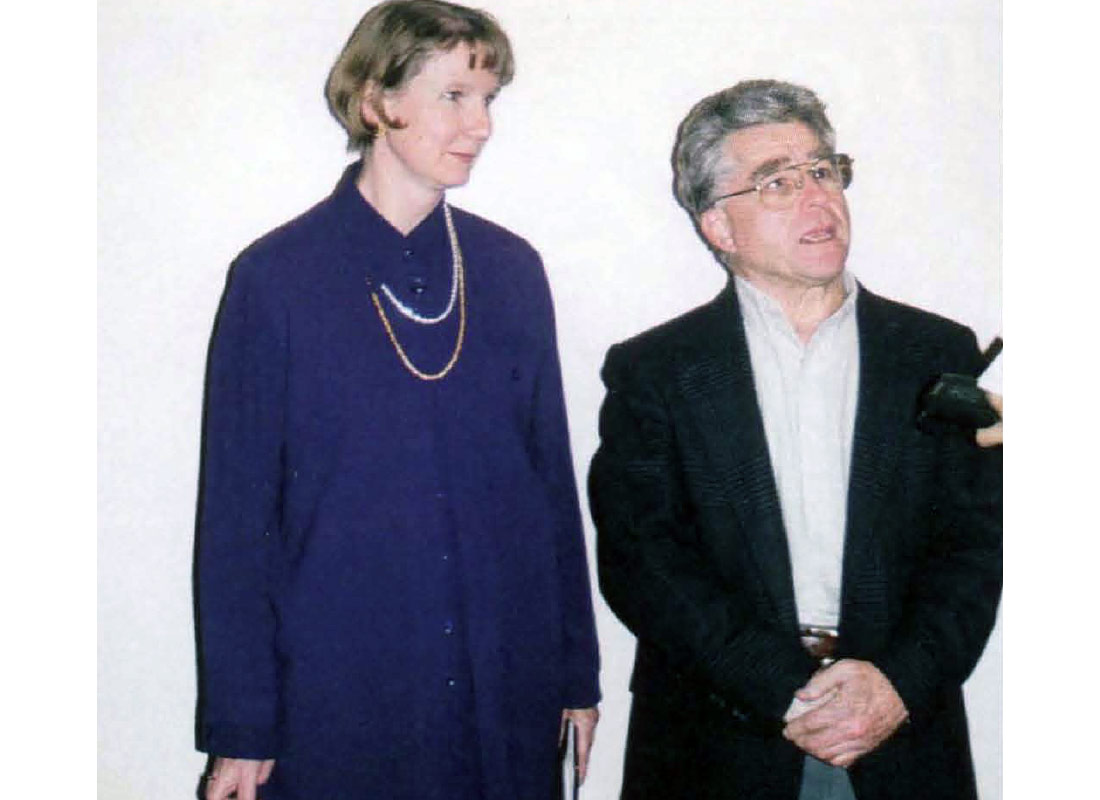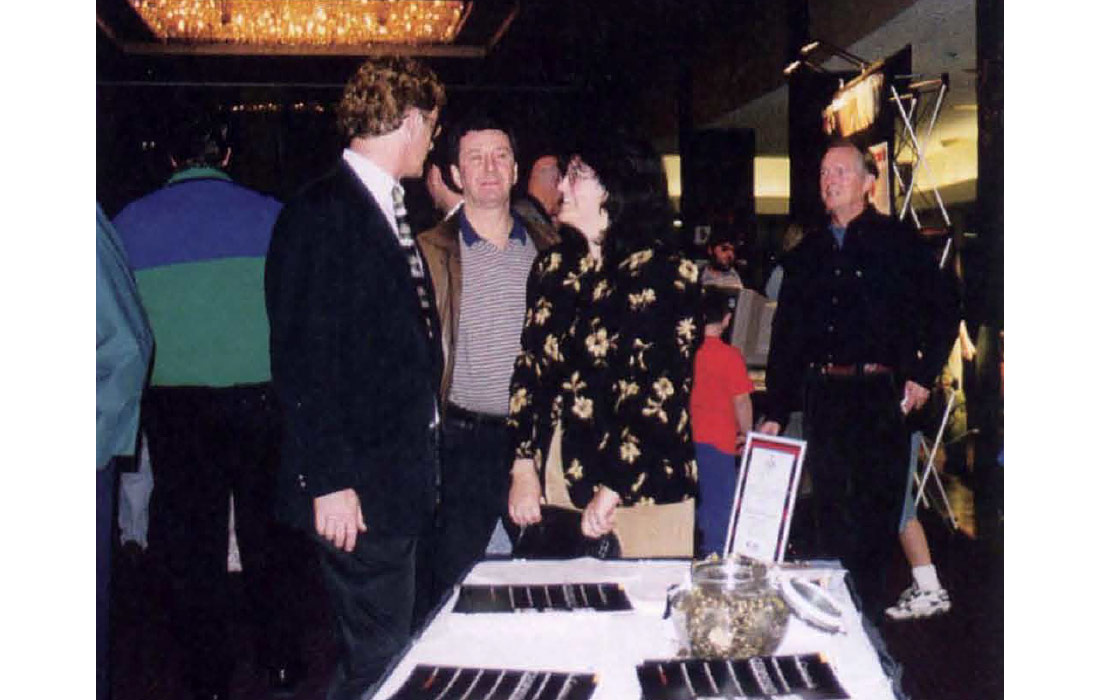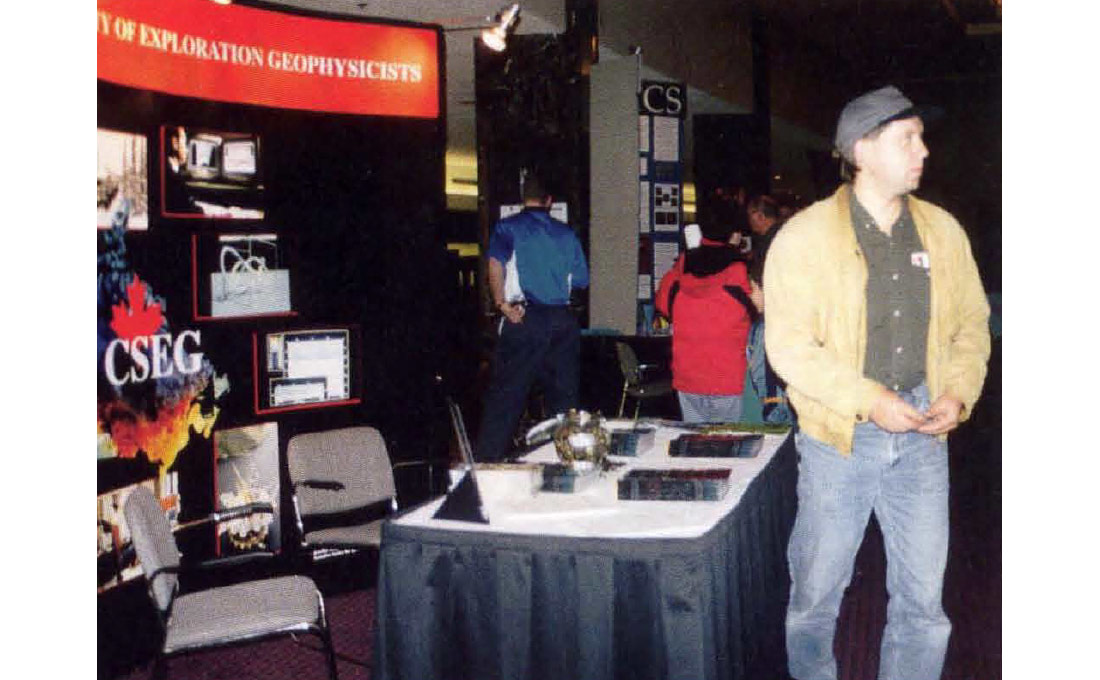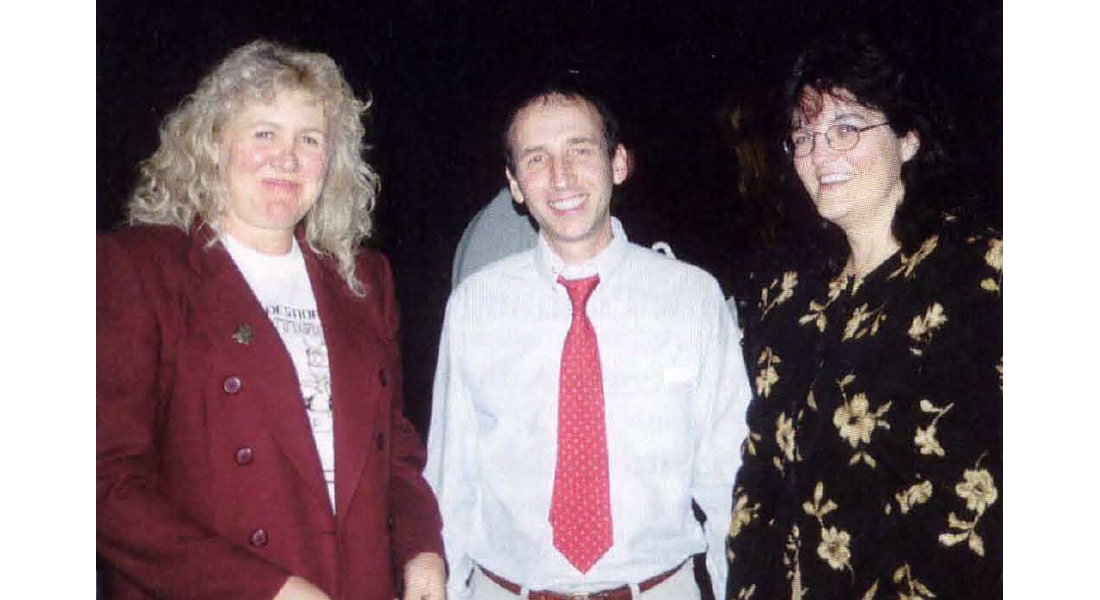The planet Mars is a mere 100 million miles away from Earth. Yet for 1,676 persons on the evening of October 6, this distance seemed insignificant at the Destination Mars CSPG/CSEG joint presentation. Here, results from the Mars Pathfinder Mission of July 1997 were revealed. Everyone gawked at the extra-ordinary pictures and 3-D images of Mars' surface.
The two speakers for the evening were award-winning geologists with long histories when it comes to solving the mysteries of Mars. Michael Carr, a geologist from the Astrogeology branch at the U.S. Geological Survey in Menlo Park, California, focused on Mars: Aquifers, Oceans and the Prospects for Life. Matthew Golombek, a Pasadena, Californian-based project scientist of NASA's Mars Pathfinder Project, took the audience on an awesome trip with his talk, The Mars Pathfinder Mission and Science Results. Carr, who has been with the U.S. Geological Survey since 1962, had previously worked on the Apollo Program in the 1960's. Back then, he prepared Moon maps and interpreted the Moon's surface and advised astronauts on what they could expect. During the 1970's Carr's research focus shifted on to the Mars and the Jovian satellites. He led the Viking Orbiter Imaging Team that acquired over 50,000 images of Mars. Currently, he's a member of the Mars Global surveyor Imaging Team, capturing high-resolution pictures of Mars.

Carr's evening dissertation dwelled on the possibility of answering the questions, "Could life ever start on Mars? Has there been water on Mars, which is essential for life? What is the evidence of life on Mars?" In his introductory remarks, Carr divulged some basic facts about Mars – that its atmosphere is only about one percent as thick as Earth's, that temperatures range from minus 140 deg. C. to slightly above freezing and that Mars, like Earth, was formed some 3.5 to 3.8 billion years ago, when our solar system was being conceived.
In reviewing the changes of topography on Mars' surface, Carr pointed out how the older Martian surfaces of more than 3.5 billion years of age are dominated by heavily cratered terrain, possibly created by falling meteorites which landed on a mud-like surface and flat moon-like terrain. Still, other parts of the Martian surface could be identified as younger surfaces of a billion years with fewer craters. According to Carr, there is evidence of volcanic activity on Mars, as with Earth, except in a different order of magnitude. While the largest volcano on Earth is two kilometres high, Olympus Mars is 550 km across at its base and is 27 km high. While Earth's crust is divided into plates, Mars appears to have a more stable crust.

With average temperatures of minus 70 to 90 deg. C. on Mars, and warm above freezing temperatures applying to the first few millimeters of topsoil, it appears that Mars is too cold for life. A two kilometer permafrost layer exists at the equator with six kilometers found at the north and south poles. "But it has not always been this way in the past. Early Mars was warm inside and there was a lot of heat above the ground. We see large flood channels downstream of where the Pathfinder landed," said Carr.
While roving green aliens were nowhere to be seen, research suggests the likelihood that water once existed on Mars. Carr flashed on to the big screen slides of shoreline ripples, erosion patterns and large channel flows that originated from surface holes, which are presently filled with nibble. There's speculation that water floods, ten thousand times the flow of the Mississippi River, could have flooded Mars, (a planet half the size of Earth), for a short period of time.

"How could huge volumes of water come out from holes in the ground?" queried Carr. He presented theories on how water trapped beneath the Martian subsurface gushed to the surface, in the same manner oil does. Faults or craters could have possibly broken the Martian permafrost layer. A big question remains as to where the water on Mars is now. Still, outflow channels, which are estimated to be one to three kilometres across, reside on the Red Planet's surface, possibly formed by underground seepage.
Carr also speculated that early Mars and early Earth had similar climatic conditions, being wet and warm. Still, the mystery prevails, as to how life on Earth came about. "We don't know if life on Earth is chance. We don't know the answer that life on Mars is probable," conceded Carr.
The Mars Pathfinder, which landed on Mars on July 4,1997, was the focus of Matthew Golombek's presentation on the findings of the Pathfinder's three-month visit to Mars. Colombek, a project scientist and lecturer, has been researching and studying Martian geology since 1983. He's worked on various NASA programs including the Mars Observer Mission.
The audience, in particular the children were delighted with Golombek's series of anecdotes, which described the challenge of engineering and operating the Pathfinder, a microwave oven-sized vehicle. The six-wheel vehicle, which was equipped with four stereo cameras and a chemical analyzer, took thee and a half years to design.

"The Pathfinder cost $250 million to build, the cost equivalent to a bad motion picture," said Golombek. There were feats of remotely maneuvering the Pathfinder, some 100 million miles away. It had to be engineered so that it would go from 22,0000 miles per hour to a dead stop in four minutes. Airbags were used to cushion the fall. The Pathfinder actually bounced fifteen times before completely stopping and from the time it settled down on Mars and deployed its airbags, it had been programmed to call Earth within 90 minutes.
For the 300-member team of the Pathfinder Project, July 4, 1997 has become an indelible memory. "It was an event that brought the world together," recalls Golombek. Some 560 million Internet hits were recorded within the first 30 days of the event.
The landing site for the Pathfinder was an area of 100 km by 120 km, downstream of an outflow channel. For three months, the Pathfinder, referred by Golombek as a "one-foot geologist" explored about 200 square meters of Martian surface. It collected 2.3 billion bits of information, including thousands of images, 16 chemical analyses of rocks and soil, and 8.5 million individual temperature, pressure and wind measurements.
The audience sported 3-D glasses to view the images from the Pathfinder as Golombek described the texture and composition of the rocks. It was an eerie sight to witness red-yellow sky against a desert like landscape.
Golombek showed slides of rocks possibly of sedimentary and volcanic origins. There were rocks that appeared to be conglomerates, evidence that there was once water on Mars. For the most part, the Martian soil was dominated by fine micron-sized dust that clumped together under the wheels on the Pathfinder. In colour, the Martian dust ranged from bright red to darker red and black. Chemical analyses of the Martian rocks indicate some rocks are high in silica, implying differential parental materials. The Pathfinder experienced a minor collision with rocks on Mars, some which were subsequently nicknamed Yogi Bear and Barnacle Bill.

In conclusion, Golombek supports evidence that Mars was once warmer and wetter than it is now. The answer to life on Mars remains inconclusive. Further missions to Mars can only be planned once every 26 months, due to the disparity of rotation between Earth and Mars. It takes 687 days for Mars, the fourth planet from the sun to complete its orbit around the Sun. Perhaps, one day, scientists may have the answer as to our planet's fascination about life on Mars.
Behind the Scenes.
It was one week before the Destination Mars presentation, when just 300 tickets had been sold. Event co-chairs, Elizabeth O'Neill of Samson Canada and Barb Rypien of Rigel, were a bit concerned. But in true Calgarian fashion, there was a deluge of tickets sold at the last moment.
"We're pleased on how the event turned out," says O'Neill, "But it was a huge amount of work."
Members of the Honorary Address Committee worked flat out, in the days, days prior to the event. O'Neill and Rypien were assisted by other committee members: Sherry Samborksi of Petro-Canada, Natalie Hachey and Tim Bird of Stoakes Consulting, Rob Stewart and Denise Hodder (University of Calgary), Denise Poley (Shell), Rob Langill (Highridge Petroleum), and Steve Hayson (Cabre).
CSEG's president Nancy Shaw delivered a slightly off the wall speaker introduction, "If neat transportation vehicles, big computers and earth sciences is the definition of cool, Matthew Golombek has to be the king of cool." And Rob Stewart graciously thanked the speakers.
Sponsors were instrumental to the event's success. Veritas Geophysical sponsored the 3D glasses. The Westin Hotel provided accommodation for the speakers. McCara Printing printed up the posters. The Calgary Sun donated advertising space. And the following companies subsidized the cost of the tickets and assisted in the promotion of the evening: Canadian Hunter, Samson, Petro-Canada, MJ Systems, Calgary Science Centre, Lite '96 CHFM, KISS FM, Rigel Energy, Petrel, BPB Wireline and Highridge Petroleum.
The stress killer for the organizers on the day of the event, was the saga about the Mars bars. TI1e evening before, it was discovered that the chocolate bars had arrived, damaged and unsafe to hand out. At 9:00 am on the morning of October 6, Effem Foods of Toronto, the sponsor that donated the chocolate bars was notified of the fiasco. They promptly responded by shipping out another batch of Mars bars, which arrived at the Jubilee Auditorium a mere thirty minutes before the event started. For the 500-plus children that attended the event, the chocolate bars was a sweet souvenir, along with glow in the dark t-shirts, and posters.











Join the Conversation
Interested in starting, or contributing to a conversation about an article or issue of the RECORDER? Join our CSEG LinkedIn Group.
Share This Article